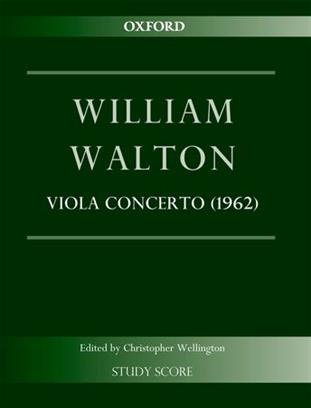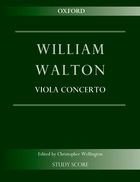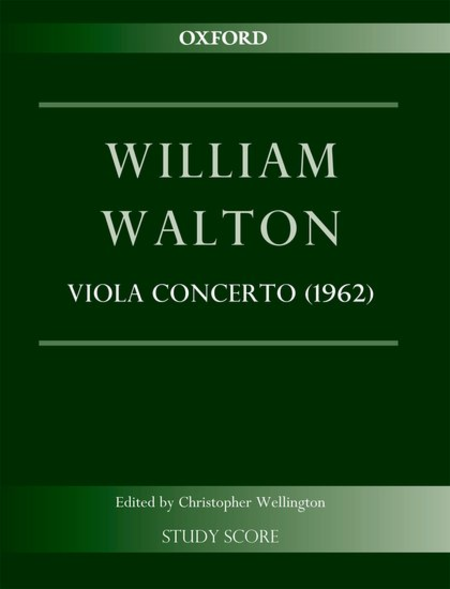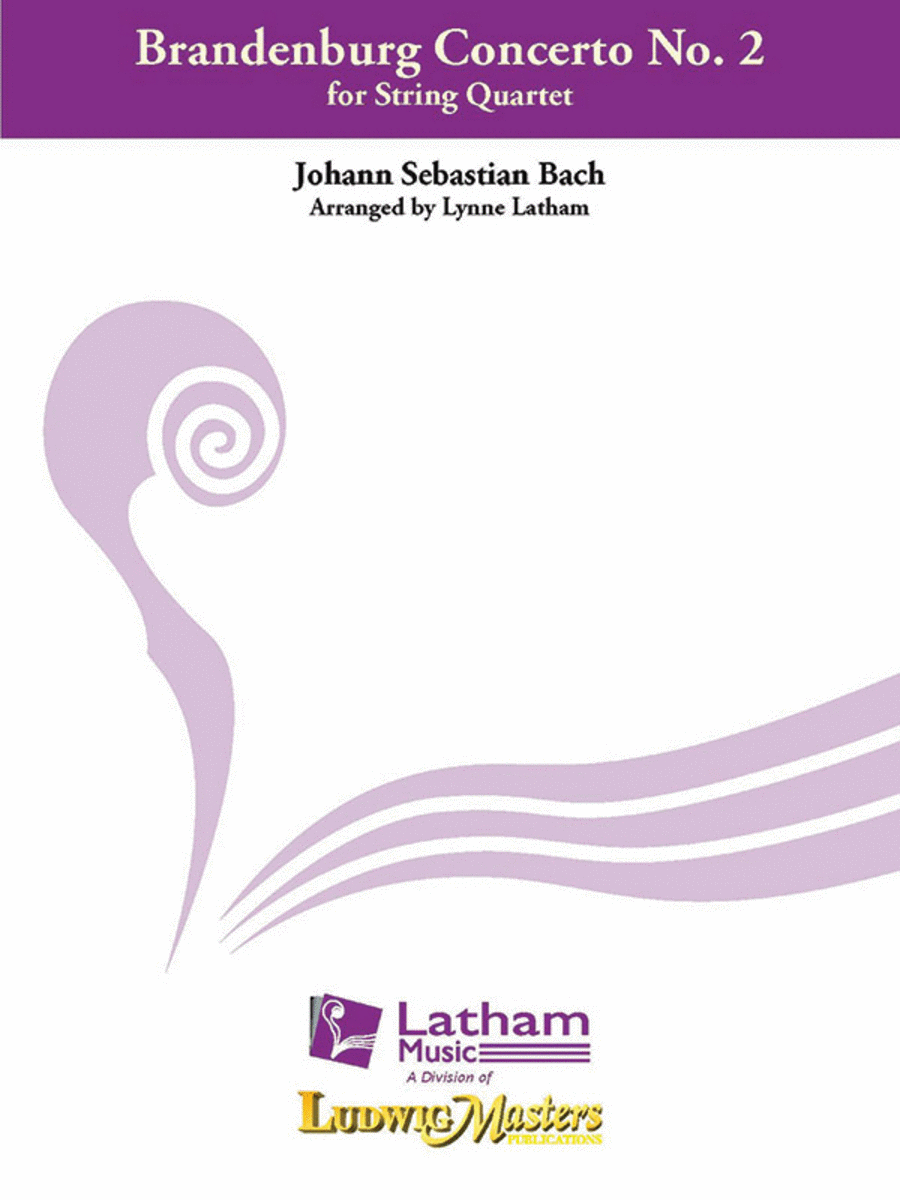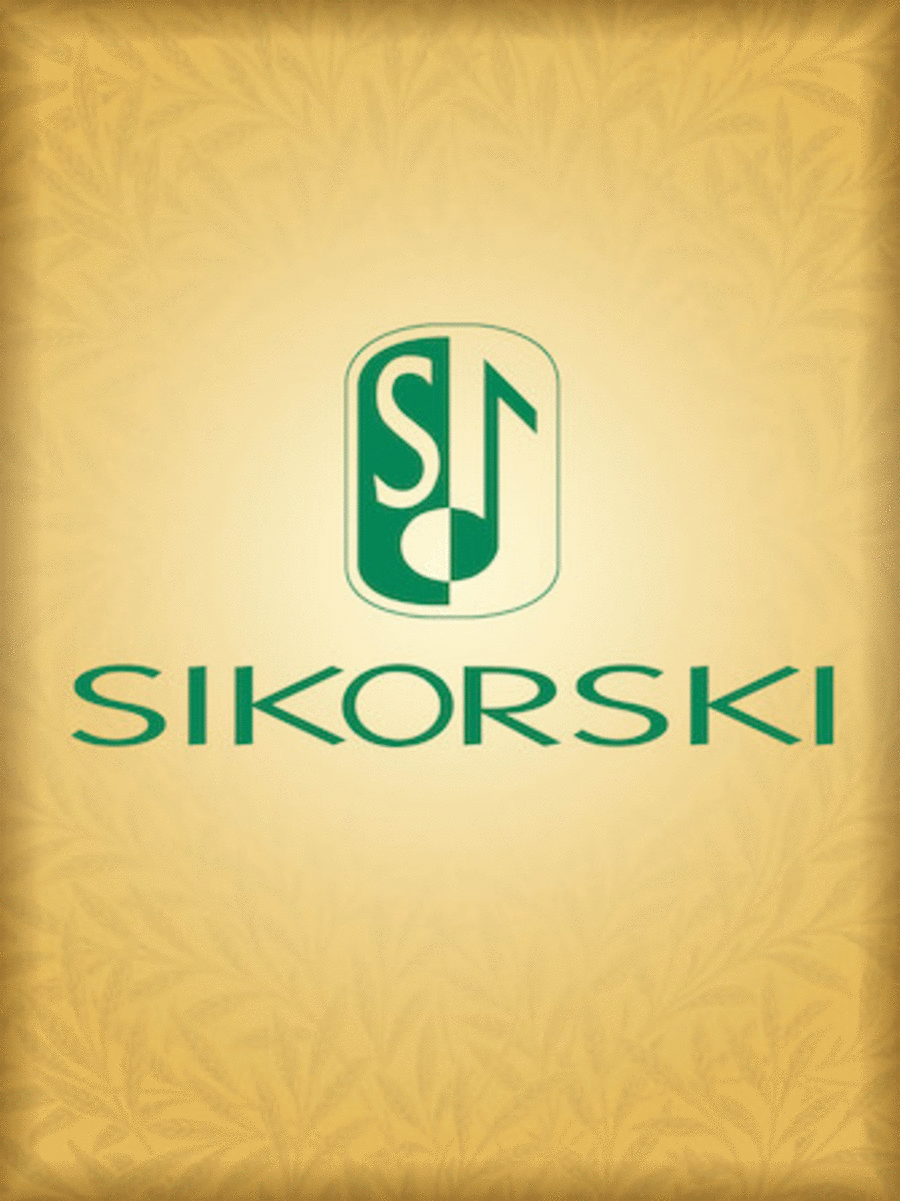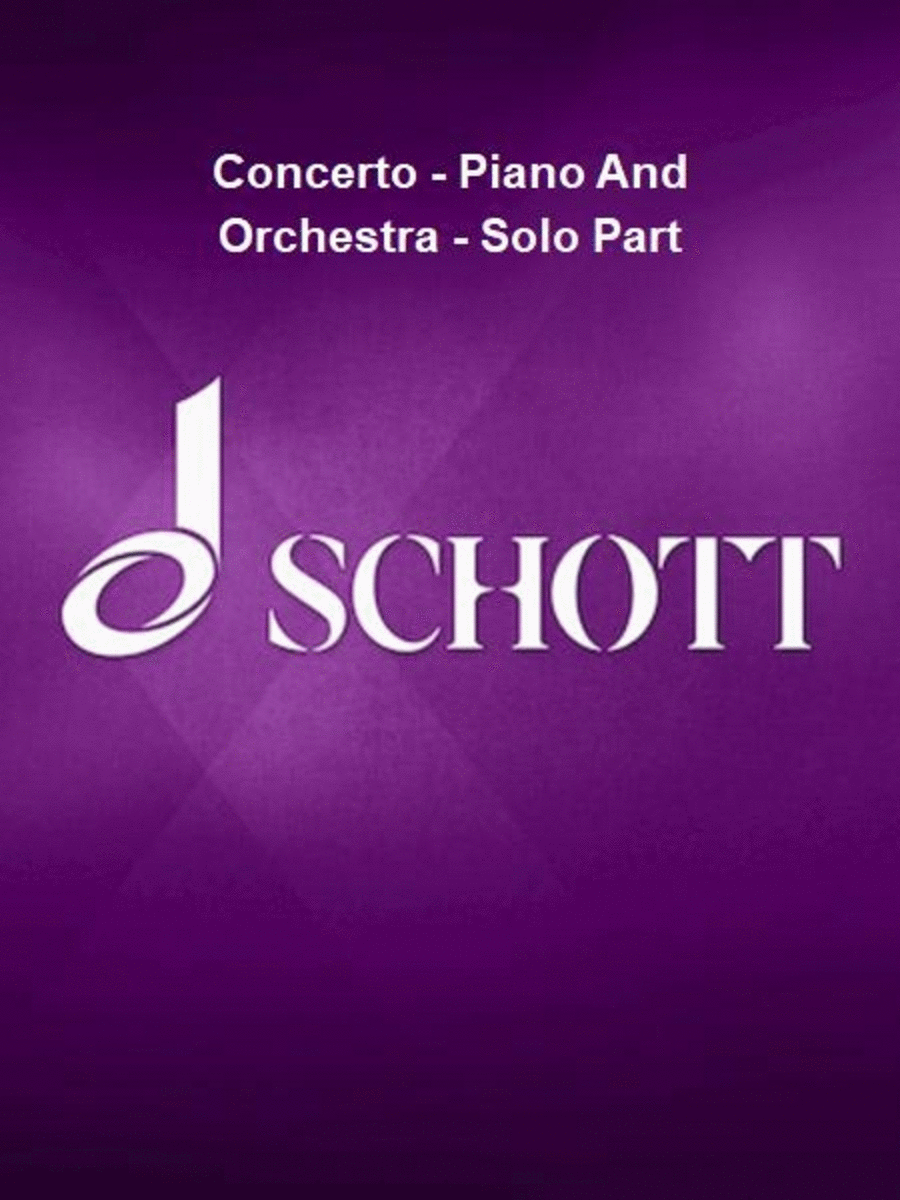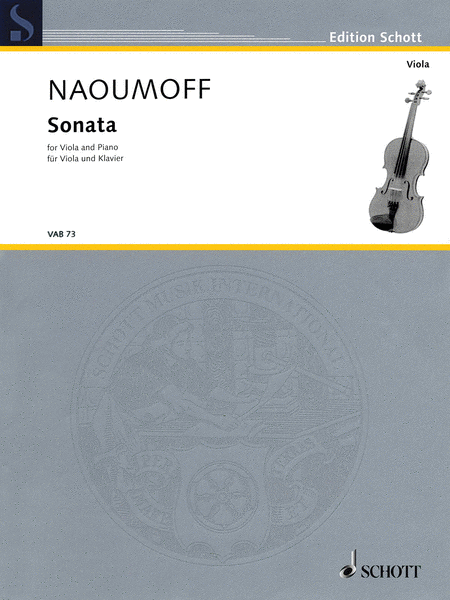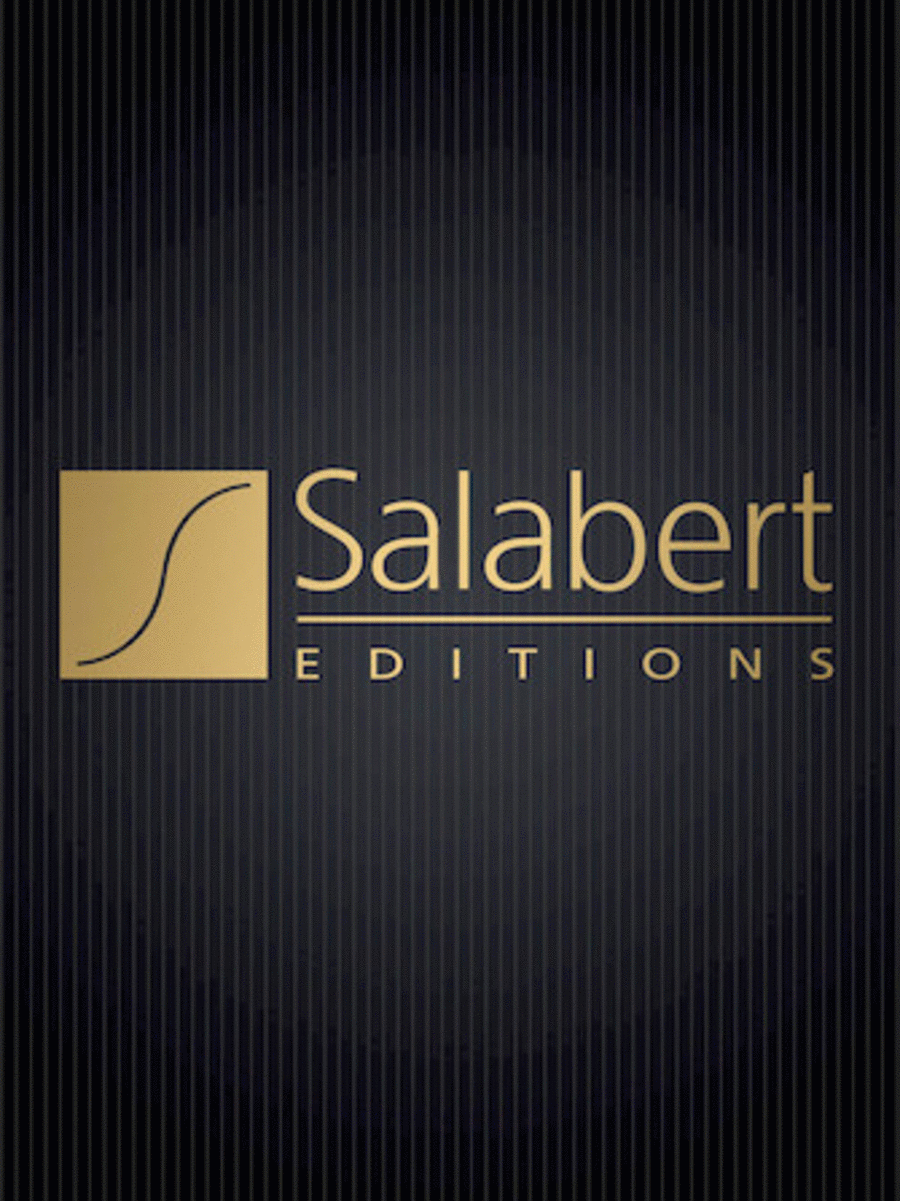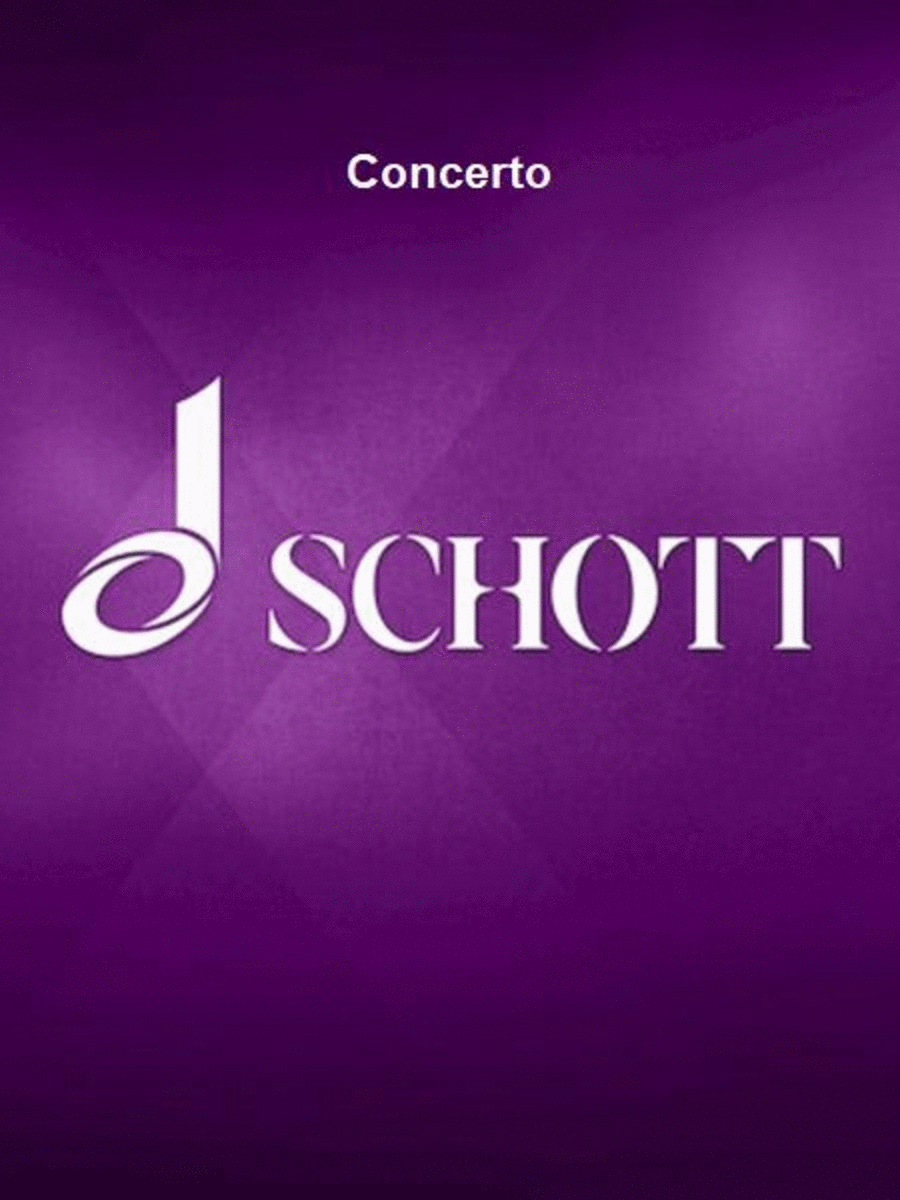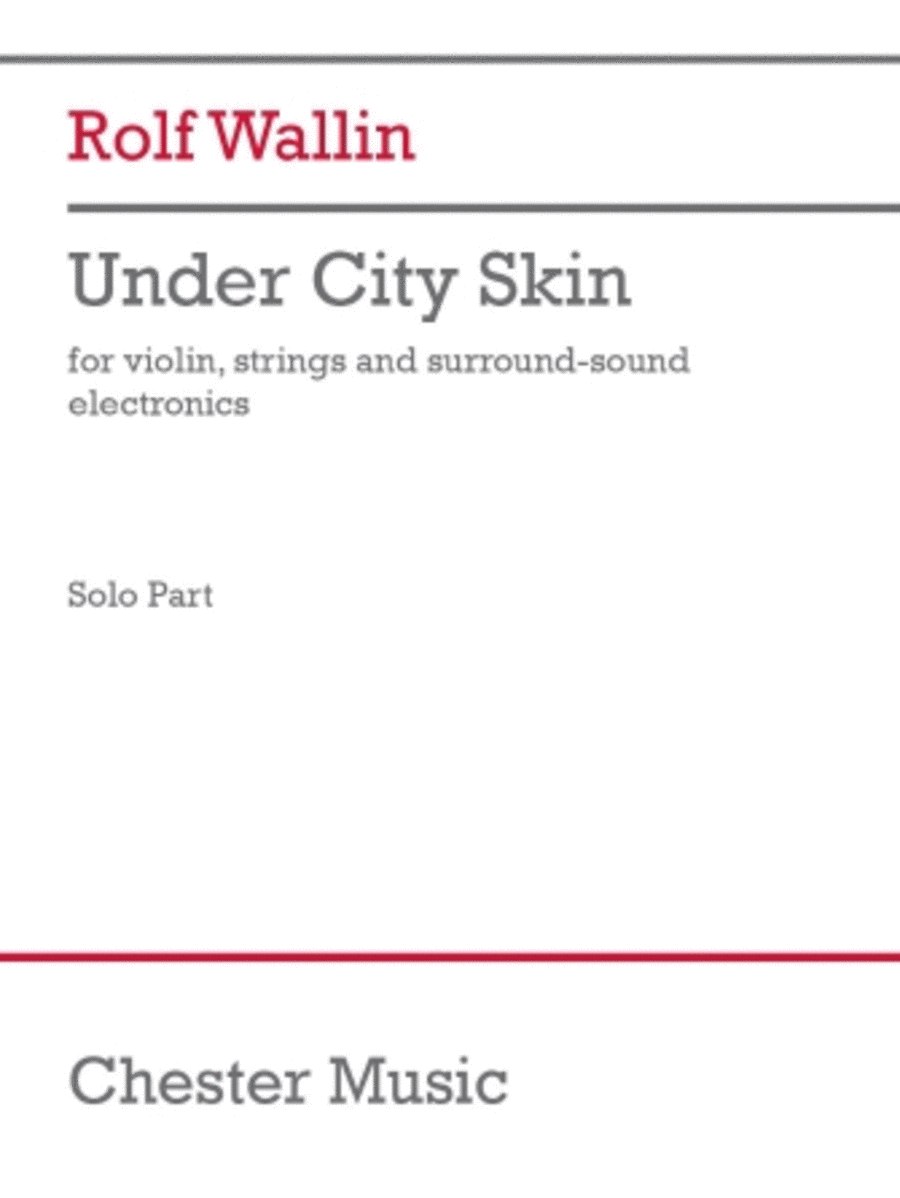|
| Viola Concerto (1962)
Alto et Orchestre [Partition] - Avancé
Oxford University Press
William Walton Edition. Par WALTON WILLIAM. for solo viola and orchestra This ed...(+)
William Walton Edition. Par WALTON WILLIAM. for solo viola and orchestra This edition of Walton's celebrated Viola Concerto (1962 version) has been off-printed from the William Walton Edition full score, and combines the scholarship of the Edition with the practical benefits of the smaller format. An introduction is provided by the volume editor, Christopher Wellington. / Niveau : Très Avancé / Répertoire / Alto et Orchestre
Délais: 2-5 jours - En Stock Fournisseur | | |
| Concerto For Viola And
Orchestra (WALTON
WILLIAM)
Alto, Piano [Partition] - Avancé
Oxford University Press
Reduction for viola and piano. Par WALTON WILLIAM. This edition of the piano red...(+)
Reduction for viola and piano. Par WALTON WILLIAM. This edition of the piano reduction is compatible with the Walton Edition full score and restores the solo line as edited and prepared by Frederick Riddle. It contains tempo markings and dynamic and expression marks from both of Walton's orchestrations (1929 and 1962), the 1962 version distinguished by lighter type. / Niveau : Avancé / Répertoire / Alto et Piano
Délais: En Stock | |
|
|
|
| Viola Concerto (1962)
Alto et orchestre [Conducteur d'étude / Miniature]
Oxford University Press
Composed by William Walton (1902-1983). Edited by Christopher Wellington. For so...(+)
Composed by William
Walton (1902-1983).
Edited by Christopher
Wellington. For solo
viola and orchestra (solo
viola - 2 flutes (II
piccolo), oboe, english
horn, 2 clarinets (II
bass clarinet), 2
bassoons, 4 horns, 2
trumpets, 3 trombones,
timpani, harp, strings).
William Walton Edition.
Pieces and Studies. Level
D (difficult). Study
score. 152 pages.
Duration 23'. Published
by Oxford University
Press
$37.99 - Voir plus => AcheterDélais: 2 to 3 weeks | | | |
| Brandenburg Concerto No. 2 for String Quartet
Quatuor à cordes: 2 violons, alto, violoncelle - Intermédiaire
Latham Music Enterprises
Violin 1, Violin 2, Viola, Cello - Grade 3.5 SKU: AP.36-52703132 Composed...(+)
Violin 1, Violin 2,
Viola, Cello - Grade 3.5
SKU:
AP.36-52703132
Composed by Johann
Sebastian Bach. Arranged
by Lynne Latham.
Performance Music
Ensemble; String Quartet.
Ludwig Masters. Score and
Part(s). Latham Music
Enterprises #36-52703132.
Published by Latham Music
Enterprises
(AP.36-52703132). ISBN
9781628761962. UPC:
660355088711.
English. Bach's
famous "Brandenburg
Concertos" are
considered by many to be
the pinnacle of the
Baroque Concerto Grosso
style. These arrangements
of the
"Brandenburgs"
for string quartet by
Lynne Latham have become
much-used by
professionals and
students alike.
These products
are currently being
prepared by a new
publisher. While many
items are ready and will
ship on time, some others
may see delays of several
months. $21.95 - Voir plus => Acheter | | | |
| Piano Concerto in G minor, Op. 25
Piano Quintette: piano, 2 violons, alto, violoncelle
Sikorski
Piano; String Quartet (Score and Parts) SKU: HL.50490497 Piano and Str...(+)
Piano; String Quartet
(Score and Parts) SKU:
HL.50490497 Piano
and String Quartet.
Composed by Felix
Bartholdy Mendelssohn.
Arranged by Cord Garben.
Ensemble. Classical.
Sikorski #SIK1741.
Published by Sikorski
(HL.50490497). ISBN
9790003037615. UPC:
196288181910.
8.25x11.75x0.18
inches.
Special Import
titles are specialty
titles that are not
generally offered for
sale by US based
retailers. These items
must be obtained from our
overseas suppliers. When
you order a special
import title, it will be
shipped from our overseas
warehouse. The shipment
time will be slower than
items shipped directly
from our US warehouse and
may be subject to
delays. $39.95 - Voir plus => Acheter | | | |
| Concerto - Piano And Orchestra - Solo Part
Schott
Piano and orchestra - difficult SKU: HL.49046544 For piano and orchest...(+)
Piano and orchestra -
difficult SKU:
HL.49046544 For
piano and orchestra.
Composed by Gyorgy
Ligeti. This edition:
Saddle stitching. Sheet
music. Edition Schott.
Softcover. Composed
1985-1988. Duration 24'.
Schott Music #ED23178.
Published by Schott Music
(HL.49046544). ISBN
9781705122655. UPC:
842819108726.
9.0x12.0x0.224
inches. I composed
the Piano Concerto in two
stages: the first three
movements during the
years 1985-86, the next
two in 1987, the final
autograph of the last
movement was ready by
January, 1988. The
concerto is dedicated to
the American conductor
Mario di Bonaventura. The
markings of the movements
are the following: 1.
Vivace molto ritmico e
preciso 2. Lento e
deserto 3. Vivace
cantabile 4. Allegro
risoluto 5. Presto
luminoso.The first
performance of the
three-movement Concerto
was on October 23rd, 1986
in Graz. Mario di
Bonaventura conducted
while his brother,
Anthony di Bonaventura,
was the soloist. Two days
later the performance was
repeated in the Vienna
Konzerthaus. After
hearing the work twice, I
came to the conclusion
that the third movement
is not an adequate
finale; my feeling of
form demanded
continuation, a
supplement. That led to
the composing of the next
two movements. The
premiere of the whole
cycle took place on
February 29th, 1988, in
the Vienna Konzerthaus
with the same conductor
and the same pianist. The
orchestra consisted of
the following: flute,
oboe, clarinet, bassoon,
horn, trumpet, tenor
trombone, percussion and
strings. The flautist
also plays the piccoIo,
the clarinetist, the alto
ocarina. The percussion
is made up of diverse
instruments, which one
musician-virtuoso can
play. It is more
practical, however, if
two or three musicians
share the instruments.
Besides traditional
instruments the
percussion part calls
also for two simple wind
instruments: the swanee
whistle and the
harmonica. The string
instrument parts (two
violins, viola, cello and
doubles bass) can be
performed soloistic since
they do not contain
divisi. For balance,
however, the ensemble
playing is recommended,
for example 6-8 first
violins, 6-8 second, 4-6
violas, 4-6 cellos, 3-4
double basses. In the
Piano Concerto I realized
new concepts of harmony
and rhythm. The first
movement is entirely
written in bimetry:
simultaneously 12/8 and
4/4 (8/8). This relates
to the known triplet on a
doule relation and in
itself is nothing new.
Because, however, I
articulate 12 triola and
8 duola pulses, an
entangled, up till now
unheard kind of polymetry
is created. The rhythm is
additionally complicated
because of asymmetric
groupings inside two
speed layers, which means
accents are
asymmetrically
distributed. These
groups, as in the talea
technique, have a fixed,
continuously repeating
rhythmic structures of
varying lengths in speed
layers of 12/8 and 4/4.
This means that the
repeating pattern in the
12/8 level and the
pattern in the 4/4 level
do not coincide and
continuously give a
kaleidoscope of renewing
combinations. In our
perception we quickly
resign from following
particular rhythmical
successions and that what
is going on in time
appears for us as
something static,
resting. This music, if
it is played properly, in
the right tempo and with
the right accents inside
particular layers, after
a certain time 'rises, as
it were, as a plane after
taking off: the rhythmic
action, too complex to be
able to follow in detail,
begins flying. This
diffusion of individual
structures into a
different global
structure is one of my
basic compositional
concepts: from the end of
the fifties, from the
orchestral works
Apparitions and
Atmospheres I
continuously have been
looking for new ways of
resolving this basic
question. The harmony of
the first movement is
based on mixtures, hence
on the parallel leading
of voices. This technique
is used here in a rather
simple form; later in the
fourth movement it will
be considerably
developed. The second
movement (the only slow
one amongst five
movements) also has a
talea type of structure,
it is however much
simpler rhythmically,
because it contains only
one speed layer. The
melody is consisted in
the development of a
rigorous interval mode in
which two minor seconds
and one major second
alternate therefore nine
notes inside an octave.
This mode is transposed
into different degrees
and it also determines
the harmony of the
movement; however, in
closing episode in the
piano part there is a
combination of diatonics
(white keys) and
pentatonics (black keys)
led in brilliant,
sparkling quasimixtures,
while the orchestra
continues to play in the
nine tone mode. In this
movement I used isolated
sounds and extreme
registers (piccolo in a
very low register,
bassoon in a very high
register, canons played
by the swanee whistle,
the alto ocarina and
brass with a harmon-mute'
damper, cutting sound
combinations of the
piccolo, clarinet and
oboe in an extremely high
register, also
alternating of a
whistle-siren and
xylophone). The third
movement also has one
speed layer and because
of this it appears as
simpler than the first,
but actually the rhythm
is very complicated in a
different way here. Above
the uninterrupted, fast
and regular basic pulse,
thanks to the asymmetric
distribution of accents,
different types of
hemiolas and inherent
melodical patterns appear
(the term was coined by
Gerhard Kubik in relation
to central African
music). If this movement
is played with the
adequate speed and with
very clear accentuation,
illusory
rhythmic-melodical
figures appear. These
figures are not played
directly; they do not
appear in the score, but
exist only in our
perception as a result of
co-operation of different
voices. Already earlier I
had experimented with
illusory rhythmics,
namely in Poeme
symphonique for 100
metronomes (1962), in
Continuum for harpsichord
(1968), in Monument for
two pianos (1976), and
especially in the first
and sixth piano etude
Desordre and Automne a
Varsovie (1985). The
third movement of the
Piano Concerto is up to
now the clearest example
of illusory rhythmics and
illusory melody. In
intervallic and chordal
structure this movement
is based on alternation,
and also inter-relation
of various modal and
quasi-equidistant harmony
spaces. The tempered
twelve-part division of
the octave allows for
diatonical and other
modal interval
successions, which are
not equidistant, but are
based on the alternation
of major and minor
seconds in different
groups. The tempered
system also allows for
the use of the
anhemitonic pentatonic
scale (the black keys of
the piano). From
equidistant scales,
therefore interval
formations which are
based on the division of
an octave in equal
distances, the
twelve-tone tempered
system allows only
chromatics (only minor
seconds) and the six-tone
scale (the whole-tone:
only major seconds).
Moreover, the division of
the octave into four
parts only minor thirds)
and three parts (three
major thirds) is
possible. In several
music cultures different
equidistant divisions of
an octave are accepted,
for example, in the
Javanese slendro into
five parts, in Melanesia
into seven parts, popular
also in southeastern
Asia, and apart from
this, in southern Africa.
This does not mean an
exact equidistance: there
is a certain tolerance
for the inaccurateness of
the interval tuning.
These exotic for us,
Europeans, harmony and
melody have attracted me
for several years.
However I did not want to
re-tune the piano
(microtone deviations
appear in the concerto
only in a few places in
the horn and trombone
parts led in natural
tones). After the period
of experimenting, I got
to pseudo- or
quasiequidistant
intervals, which is
neither whole-tone nor
chromatic: in the
twelve-tone system, two
whole-tone scales are
possible, shifted a minor
second apart from each
other. Therefore, I
connect these two scales
(or sound resources), and
for example, places occur
where the melodies and
figurations in the piano
part are created from
both whole tone scales;
in one band one six-tone
sound resource is
utilized, and in the
other hand, the
complementary. In this
way whole-tonality and
chromaticism mutually
reduce themselves: a type
of deformed
equidistancism is formed,
strangely brilliant and
at the same time
slanting; illusory
harmony, indeed being
created inside the
tempered twelve-tone
system, but in sound
quality not belonging to
it anymore. The
appearance of such
slantedequidistant
harmony fields
alternating with modal
fields and based on
chords built on fifths
(mainly in the piano
part), complemented with
mixtures built on fifths
in the orchestra, gives
this movement an
individual, soft-metallic
colour (a metallic sound
resulting from
harmonics). The fourth
movement was meant to be
the central movement of
the Concerto. Its
melodc-rhythmic elements
(embryos or fragments of
motives) in themselves
are simple. The movement
also begins simply, with
a succession of
overlapping of these
elements in the mixture
type structures. Also
here a kaleidoscope is
created, due to a limited
number of these elements
- of these pebbles in the
kaleidoscope - which
continuously return in
augmentations and
diminutions. Step by
step, however, so that in
the beginning we cannot
hear it, a compiled
rhythmic organization of
the talea type gradually
comes into daylight,
based on the simultaneity
of two mutually shifted
to each other speed
layers (also triplet and
duoles, however, with
different asymmetric
structures than in the
first movement). While
longer rests are
gradually filled in with
motive fragments, we
slowly come to the
conclusion that we have
found ourselves inside a
rhythmic-melodical whirl:
without change in tempo,
only through increasing
the density of the
musical events, a
rotation is created in
the stream of successive
and compiled, augmented
and diminished motive
fragments, and increasing
the density suggests
acceleration. Thanks to
the periodical structure
of the composition,
always new but however of
the same (all the motivic
cells are similar to
earlier ones but none of
them are exactly
repeated; the general
structure is therefore
self-similar), an
impression is created of
a gigantic, indissoluble
network. Also, rhythmic
structures at first
hidden gradually begin to
emerge, two independent
speed layers with their
various internal
accentuations. This
great, self-similar whirl
in a very indirect way
relates to musical
associations, which came
to my mind while watching
the graphic projection of
the mathematical sets of
Julia and of Mandelbrot
made with the help of a
computer. I saw these
wonderful pictures of
fractal creations, made
by scientists from Brema,
Peitgen and Richter, for
the first time in 1984.
From that time they have
played a great role in my
musical concepts. This
does not mean, however,
that composing the fourth
movement I used
mathematical methods or
iterative calculus;
indeed, I did use
constructions which,
however, are not based on
mathematical thinking,
but are rather craftman's
constructions (in this
respect, my attitude
towards mathematics is
similar to that of the
graphic artist Maurits
Escher). I am concerned
rather with intuitional,
poetic, synesthetic
correspondence, not on
the scientific, but on
the poetic level of
thinking. The fifth, very
short Presto movement is
harmonically very simple,
but all the more
complicated in its
rhythmic structure: it is
based on the further
development of ''inherent
patterns of the third
movement. The
quasi-equidistance system
dominates harmonically
and melodically in this
movement, as in the
third, alternating with
harmonic fields, which
are based on the division
of the chromatic whole
into diatonics and
anhemitonic pentatonics.
Polyrhythms and harmonic
mixtures reach their
greatest density, and at
the same time this
movement is strikingly
light, enlightened with
very bright colours: at
first it seems chaotic,
but after listening to it
for a few times it is
easy to grasp its
content: many autonomous
but self-similar figures
which crossing
themselves. I present my
artistic credo in the
Piano Concerto: I
demonstrate my
independence from
criteria of the
traditional avantgarde,
as well as the
fashionable
postmodernism. Musical
illusions which I
consider to be also so
important are not a goal
in itself for me, but a
foundation for my
aesthetical attitude. I
prefer musical forms
which have a more
object-like than
processual character.
Music as frozen time, as
an object in imaginary
space evoked by music in
our imagination, as a
creation which really
develops in time, but in
imagination it exists
simultaneously in all its
moments. The spell of
time, the enduring its
passing by, closing it in
a moment of the present
is my main intention as a
composer. (Gyorgy
Ligeti). $34.00 - Voir plus => AcheterDélais: 24 hours - In Stock | | | |
| Sonata
Alto, Piano
Schott
Piano Accompaniment; Viola - difficult SKU: HL.49018776 Viola and Pian...(+)
Piano Accompaniment;
Viola - difficult SKU:
HL.49018776 Viola
and Piano. Composed
by Emile Naoumoff. This
edition: Saddle
stitching. Sheet music.
String. Classical.
Softcover. Composed
2001/2009. 46 pages.
Duration 20'. Schott
Music #VAB73. Published
by Schott Music
(HL.49018776). ISBN
9790001174107.
9.0x12.0x0.135
inches. The
one-movement, yet
multiple time structured,
sonata uses a gently
modern tonal language and
has been influenced by
the French tradition.
Emile Naoumoff likes to
give his movements
unusual headings that
perfectly describe the
character of the
respective section. The
piece for the combination
of viola and piano, which
is quite rare in concert
life, is a valuable and
fascinating addition to
the repertoire in which
both instruments conduct
a dialogue on an equal
basis.Naoumoff was born
in Sofia in 1962. At the
age of 8, he began his
career as a pianist and
composer; for ten years,
he was a pupil of Nadia
Boulanger until her
death. At the age of 10,
Naoumoff composed and
performed his own piano
concerto under the
direction of Yehudi
Menuhin. Many prizes,
awards and appearances as
a celebrated pianist
followed. Today Naoumoff
lives and works as an
associate professor at
the School of Music of
the Indiana University in
Bloomington. He holds
master classes in the
USA, Europe and Japan and
is director of a music
academy. $29.99 - Voir plus => Acheter | | | |
| Concerto in C Minor
Salabert
Piano Accompaniment; Viola (Viola With Piano Accompaniment) SKU: HL.50603847<...(+)
Piano Accompaniment;
Viola (Viola With Piano
Accompaniment) SKU:
HL.50603847 Viola
and Piano. Composed
by Johann Christian Bach.
Arranged by Henri
Casadesus. String.
Classical. Softcover.
Editions Salabert
#SLB2032701. Published by
Editions Salabert
(HL.50603847). ISBN
9781705149980. UPC:
196288016700.
9.0x12.0x0.144
inches. Henri
Casadesus was passionate
about early instruments,
as we know from a number
of photographs showing
him with viola d'amore,
the subject of a manual
he wrote entitled
Tecnique de la viole
d'amour. The Concerto en
Ut mineur was first
published in 1947 by Mica
Salabert. The first
edition gives the
so-called
“originalâ€
part for solo violocello
together with the score
which, according to the
preface, has been adapted
for viola or cello or
violin by Casadesus.
However, stylistic
analysis of the piece,
together with some
musicological research
carried out after the
appearance of the first
edition reveals that the
“originalâ€
version for violoncello,
onwhich the adaptation
was supposed to be based,
cannot be attributed to
Johann Christian Bach,
but is rather a work
imitating his style
written two centuries
later. In spite of this,
Concerto en Ut mineur
encountered considerable
success and continues to
be studied and performed
by both violinists and
violoncellists today. $21.99 - Voir plus => AcheterDélais: 24 hours - In Stock | | | |
| Concerto
Accordéon
Schott
Accordion; Piano Accompaniment (Accordion) SKU: HL.49047051 For Accord...(+)
Accordion; Piano
Accompaniment (Accordion)
SKU: HL.49047051
For Accordion and
Piano Reduction
(Orchestra). Composed
by Krzysztof Penderecki.
Edited by Maciej
Frackiewicz. Edition
Schott. Classical.
Softcover. 76 pages.
Duration 1320 seconds.
Schott Music #ED23680.
Published by Schott Music
(HL.49047051). UPC:
196288111108. Conce
rto for accordion and
orchestra based on the
Concerto doppio for
violin, viola
(violoncello) and
orchestra (2012) arranged
by Maciej Frackiewicz
(2017). Piano reduction
by Olga Kroupova and
Miroslav Kroupa. $58.00 - Voir plus => Acheter | | | |
| Under City Skin - Violin Version (Solo Part)
Chester
SKU: HL.50605263 Composed by Rolf Wallin. String. Softcover. Duration 180...(+)
SKU: HL.50605263
Composed by Rolf Wallin.
String. Softcover.
Duration 1800 seconds.
Chester Music #CH88250.
Published by Chester
Music (HL.50605263).
ISBN 9781705172773.
UPC: 196288091363.
9.0x12.0 inches. A
concerto inspired by
Medieval bestiaries,
updated to reflect the
sounds and sights of the
modern city: The
Mercedes, The High-heeled
Shoes, The Park at Night,
The Cash Register, The
Bus, The City Hall Bells.
As the composer writes:
'In Berlioz's famous
viola concerto, young
Harold goes to Italy to
broaden his mind. Here
our protagonist goes
under the skin of the
city sounds, in a quest
to find out what forces
are hiding within.'. $16.99 - Voir plus => AcheterDélais: 1 to 2 weeks | | |
|
|

